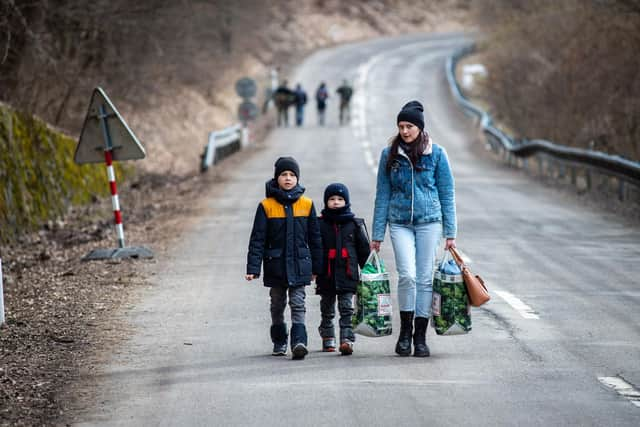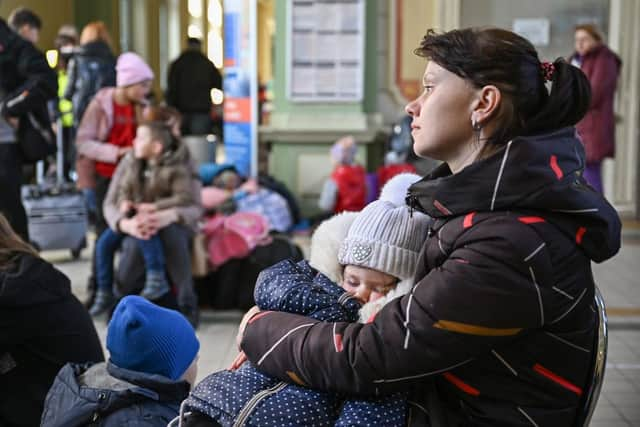How to help children with worries and questions about the war in Ukraine
and live on Freeview channel 276
The world may feel like a scary, uncertain place at the moment due to recent events covered in the news. We may not be sure what to think, how to feel or what to do. That is ok, you are not alone.
You may feel sad, angry, scared or worried. Your child might also be feeling some of these same feelings, and that is ok – it’s natural to struggle when times are uncertain, whatever our age.
Advertisement
Hide AdAdvertisement
Hide AdHere are some simple but helpful ways to support your child (they can also be helpful for yourself too) if they are worried about current world events.


Be curious
Be curious and ask your child how they might be feeling (it is best not to assume we know!). Help your child to put a name to their feelings. You might ask open questions like ‘What are you worried about?’ or ‘What do you think might happen?’ to get more information. Worry isn’t just in our heads either. You might ask them if they feel any physical anxiety e.g ‘Do you feel worried in your body anywhere?’. Sharing your own physical feelings can help e.g ‘I feel a bit sick when I worry a lot’.
Normalise
It is understandable that seeing and hearing things on the news, or from other children and adults might be upsetting. One of the best ways we can support children is to normalise what they are feeling. Saying something like ‘I know it all sounds a bit scary… it’s ok to feel worried about it. I felt worried when I saw the news too’. Try to avoid the old ‘don’t worry’ line – if it was as easy as that, none of us would ever worry about anything again! Just remind them that you are there to listen.


Check Understanding
It can be helpful for managing worry, to check what your child knows and understands about what’s going on so you can ensure they have an accurate idea (not just opinions or myths from the playground!). Don’t be afraid to answer questions honestly at a level appropriate to their age, or be honest in saying ‘I don’t know the answer to that’ if you don’t. Visuals or analogies may be helpful in explaining what is happening e.g ‘it’s a bit like there’s a big fight happening in the playground and we’re watching from the classroom’
Advertisement
Hide AdAdvertisement
Hide AdIt might be helpful to watch age appropriate news sources e.g. Newsround with your child to help explain things and answer any questions. Be mindful of leaving the news on the TV or newspapers lying around, as information may be misinterpreted and cause further worry.
‘What will happen?’
If your child has additional support needs, change and routine may be even more of a worry. Most children may find it reassuring to know that what’s happening will not immediately be changing anything about their lives or their current routine. For example, that they will still be going to school and still going swimming on Fridays.
Write it out
Help your child to talk about, write about, or draw their feelings. Having a worry box or envelope is a helpful tool for children who are particularly anxious. This involves getting them to write down or draw their worry then put it into the box where it can just ‘be’, without them having to keep thinking about it. It often helps children just to get the worry out of their head and onto paper, as it feels like they have done something to deal with the worry.
Soothe and Relax
Try some soothing activities with your child to help them relax and regulate. This could be listening to their favourite calm or uplifting music. It could be having a cuddle on the sofa. One great tool we often suggest is having a ‘Self-Soothe Box’. This involves filling a box with things that are calming for your child that you can go to in times of worry. Fill the box with activities like colouring sheets, books, pictures, toys, a favourite smell or snack. Using your senses (sight, smell, touch, taste, sound) can help us feel more relaxed, so choosing an activity to put in the box that engages your child’s senses will be helpful.
Advertisement
Hide AdAdvertisement
Hide AdLimiting information
For older children and teenagers especially, there are constant streams of news and videos on social media. This can be hard to avoid, even if they are not meaning to look for it. There are usually ways to block certain words on social media to prevent posts from appearing, and putting on filters for blocking potentially triggering content. It may be helpful to sit with your child and see where distressing content could be limited or controlled on each app.
Remind them that it is also ok not to think about it too! The most important thing you can do as a family is to keep to usual routines and focus on all the important things you do in your daily lives. We cannot change world events or solve our child’s worries. What we can do is be there to listen to their worries, and help them find ways of expressing those worries when they come up, through some of the tools mentioned above. If any of these sound like they would be helpful, give them a go!